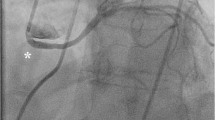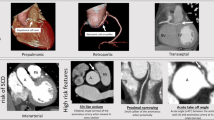Abstract
Purpose of Review
Comprehensive discussion of alternative techniques in imaging coronary artery anomalies (CAAs) in different diagnostic scenarios.
Recent Findings
At primary screening, intramural course essentially correlates with stenosis and clinical repercussion in some types of CAAs. Potential clinical aims in imaging patients with CAAs may be primary screening, severity evaluation, preoperative planning, and postoperative follow-up. Appropriate techniques are echocardiography, magnetic resonance imaging, computed tomography angiography, and intravascular ultrasound (IVUS). Rarely, IVUS may be needed in patients with potentially serious CAAs and has unique advantages and limitations. IVUS data are essential for in-depth knowledge of mechanisms of coronary dysfunction (exercise-related dynamic stenosis of variable severity) and for indicating interventional treatment.
Summary
In adolescents or adults, intramural course of an anomalous coronary artery is the only important feature accompanied by stenosis of potential severity and is especially relevant in patients with a high-risk status (elite sport athletes, military recruits).




Similar content being viewed by others
References
Papers of particular interest, published recently, have been highlighted as: • Of importance •• Of major importance
Angelini P. Normal and anomalous coronary arteries: definitions and classification. Am Heart J. 1989;117:418–34.
Angelini P. Novel imaging of coronary artery anomalies to assess their prevalence, the causes of clinical symptoms, and the risk of sudden cardiac death. Circ Cardiovasc Imaging. 2014;7:747–54.
Poynter JA, Williams WG, McIntyre S, Brothers JA, Jacobs ML, the Congenital Heart Surgeons Society AAOCA Working Group, et al. Anomalous aortic origin of a coronary artery: a report from the Congenital Heart Surgeons Society Registry. World J Pediatr Congenit Heart Surg. 2014;5:22–30.
Angelini P, Cheong BY, Lenge De Rosen VV, et al. Magnetic resonance imaging-based screening study in a general population of adolescents. J Am Coll Cardiol. 2018;71:579–80.
Grani C, Benz DC, Schmied C, et al. Hybrid CCTA/SPECT myocardial perfusion imaging findings in patients with anomalous origin of coronary arteries from the opposite sinus and suspected concomitant coronary artery disease. J Nucl Cardiol. 2017;24:226–34.
Angelini P, Villanson S, Chan AVJ, et al. Normal and anomalous coronary artery in humans. In: Angelini P, Fairchild V, editors. Coronary artery anomalies: a comprehensive approach. Baltimore: Lippincott, Williams & Wilkins; 1999. p. 27–150.
•• Angelini P, Uribe C. Anatomic spectrum of left coronary artery anomalies and associated mechanisms of coronary insufficiency. Catheter Cardiovasc Interv. 2018;92:313–21 Findings from this report explain the wide spectrum of presentation of high-risk cases of left coronary anomalies, based on intravascular ultrasound imaging.
• Angelini P, Uribe C, Monge J, et al. Origin of the right coronary artery from the opposite sinus of Valsalva in adults: characterization by intravascular ultrasonography at baseline and after stent angioplasty. Catheter Cardiovasc Interv. 2015;86:199–208 This report explains the fundamental mechanism of ischemia in any coronary anomaly with an intramural course, as shown by intravascular ultrasound.
•• Angelini P, Cheong BY, Lenge De Rosen VV, et al. High-risk cardiovascular conditions in sports-related sudden death: prevalence in 5,169 schoolchildren screened via cardiac magnetic resonance. Tex Heart Inst J. 2018;45:205–13 This report describes the unprecedented findings of a large general population screening study, based on an accurate imaging technique (screening MRI).
Eckart RE, Scoville SL, Campbell CL, Shry EA, Stajduhar KC, Potter RN, et al. Sudden death in young adults: a 25-year review of autopsies in military recruits. Ann Intern Med. 2004;141:829–34.
Smallman DP, Webber BJ, Mazuchowski EL, Scher AI, Jones SO, Cantrell JA. Sudden cardiac death associated with physical exertion in the US military, 2005-2010. Br J Sports Med. 2016;50:118–23.
Harmon KG, Asif IM, Klossner D, Drezner JA. Incidence of sudden cardiac death in National Collegiate Athletic Association athletes. Circulation. 2011;123:1594–600.
Maron BJ, Doerer JJ, Haas TS, Tierney DM, Mueller FO. Sudden deaths in young competitive athletes: analysis of 1866 deaths in the United States, 1980-2006. Circulation. 2009;119:1085–92.
Toresdahl BG, Rao AL, Harmon KG, Drezner JA. Incidence of sudden cardiac arrest in high school student athletes on school campus. Heart Rhythm. 2014;11:1190–4.
Angelini P, Flamm SD. Newer concepts for imaging anomalous aortic origin of the coronary arteries in adults. Catheter Cardiovasc Interv. 2007;69:942–54.
Cheong BY, Angelini P. Magnetic resonance imaging of the coronary arteries. In: Willerson JT, Holmes DR, editors. Coron Artery Dis. London: Springer-Verlag; 2007. p. 283–338.
Angelini P. Is echocardiography adequate to identify the severity of anomalous coronary arteries? JACC Cardiovasc Imaging. 2016;9:898–9.
• Malhotra A, Dhutia H, Finocchiaro G, Gati S, Beasley I, Clift P, et al. Outcomes of cardiac screening in adolescent soccer players. N Engl J Med. 2018;379:524–34 This large echocardiography screening study follows a large group of soccer players for a significant period of time and documents the limitations of such a screening program.
Lee SE, Yu CW, Park K, Park KW, Suh JW, Cho YS, et al. Physiological and clinical relevance of anomalous right coronary artery originating from left sinus of Valsalva in adults. Heart. 2016;102:114–9.
Acknowledgments
Dr. Carlo Uribe has provided expert assistance with the imaging used in this manuscript.
Author information
Authors and Affiliations
Corresponding author
Ethics declarations
Conflict of Interest
Paolo Angelini declares that he has no conflict of interest.
Human and Animal Rights and Informed Consent
This article does not contain any studies with human or animal subjects performed by any of the authors.
Additional information
Publisher’s Note
Springer Nature remains neutral with regard to jurisdictional claims in published maps and institutional affiliations.
This article is part of the Topical Collection on Echocardiography
Rights and permissions
About this article
Cite this article
Angelini, P. Imaging Approaches for Coronary Artery Anomalies: Purpose and Techniques. Curr Cardiol Rep 21, 101 (2019). https://doi.org/10.1007/s11886-019-1188-7
Published:
DOI: https://doi.org/10.1007/s11886-019-1188-7




